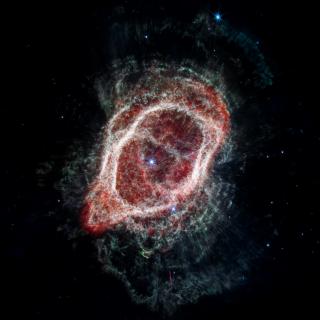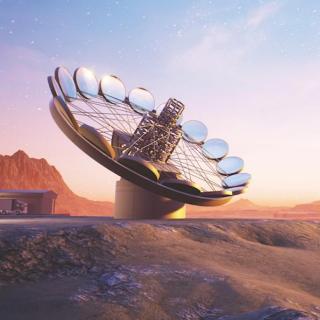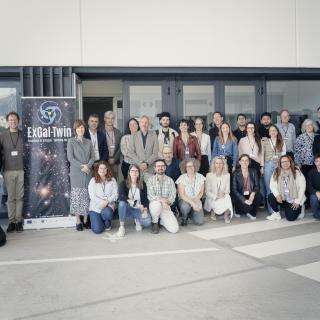Research carried out by a scientific team from the University of Heidelberg (UH), the Instituto de Astrofísica de Canarias (IAC) and the National Autonomous University of Mexico (UNAM) has allowed them to solve the abundance discrepancy, a puzzle over 80 years old, about the chemical composition of the Universe. They find that the effect of the variations in temperatura in the large gas clouds where stars are born has led to the underestimation of the quantity of heavy elements in the Universe. The results have been published in the prestigious journal Nature.
All the stars are born, live and die and, in a way, this governs the existence of life. At an early stage all the matter in the universe comprised hydrogen and helium (the two simplest chemical elements), with a tiny quantity of lithium. The rest of the elements, such as carbon and oxygen, essential for living creatures, were formed afterwards, via different processes related to the evolution and death of the stars. This what is behind the well known phrase “we are made of stardust”.
Between the phases of the death of stars and the birth of new stars matter accumulates in huge clouds of gas which are illuminated by the newborn stars. Those clouds nearest to the stars are called HII regions; the Orion Nebula is the best known. The light these regions emit can be observed even from the most distant galaxies, and they are of key importance for tracing star formation and for determining the chemical composition of the Universe. However the different ways of studying HII regions have led to discrepant results during the past 80 years.
Discovering the structure of the atom was necessary in order to make major progress in discovering the structure and composition of the Universe using spectroscopy. This technique, which allows us to analyze the chemical composition of matter via the dispersión of light, gives information about the proportion of chemical elements, their temperatures, densities, velocities, etc. This “bar code” is composed of lines, and each line is associated with differences in energy which are unique to a given element, according to the composition and physical conditions of the light source.
However since 1942 it was found that for the same atom the bright lines produced by collisions between the atom and surrounding electron (excited collisionally lines) yield abundances which are about one half of the values obtained from lines which are produced by the capture of electrons (recombination lines). So that to determine which is the correct value for the abundances of chemical elements in a nebula has been a puzzle for many astrononmers for over eight decades.
A new perspective
During this long period of time several hypotheses have been proposed to explain the discrepancy. One of the most notable was suggested in 1967 by Manuel Peimbert, a researcher at the UNAM, and a co-author of the present article. According to this astrophysicist, the brightness of the collisionally excited lines depends strongly on the temperatura. If this has variations the chemical abundances will be underestimated. On the contrary recombination lines do not have this poblem, and so should give the correct values.
For César Esteban, and IAC researcher and professor at the University of La Laguna, a co-author of the article, there is an additional problema: “One of the main difficulties for quantifying the abundance discrepancyis that the recombination lines of the heavy elements are very difficult to observe, as they are 10,000 times weaker than the collisionally excited lines produced by the same atom.
This challenge motivated the research team to use the biggest and most advanced telescopes in the world, among them the Gran Telescopio Canarias (the GTC) at the Roque de los Muchachos Observatory, La Palma. “After more than 20 years of observing and analyzing in detail a large number of HII regions our group at the IAC has acquired a set of data for our Milky Way and other galaxies of unprecedented quality, which has made this result possible” explains Jorge García Rojas, another IAC researcher and a co-author of the article.
Thanks to the high quality of the data, the team has managed to fit together all the piees of the puzle, to show that temperature variations are indeed present, not in the whole of the nebula, but concentrated in the interior most highly ionized zones. “In fact we found to our surprise that the temperatura calculated from the forbidden lines of nitrogen [NII] is representative of the mean value for the outer zones of the nebulae, and can therefore be used to calculate the correct values of the chemical abundances” explains José Eduardo Méndez Delgado, a researcher at the University of Heidelberg, and the first author of the article. “The observational evidence was already available, it was only necessary to look at it with the correct perspective” he added.
Using this new scenario the research team has been able to show that the large majority of previous studies based on the analysis of the bright collisionally excited lines have underestimated the abundances of heavy elements. “Furthermore, the evidence suggests that this effect could be larger in the less evolved objects in the Universe, such as the distant, young galaxies which we are now discovering with the James Webb Space Telescope” comments Kathryn Kreckel, a researcher at the UH, and a co-author of the article.
The study also proposes a series of relations which will allow astronomers to make correct estimates of heavy elements without needing to observe the weak recombination lines. “This will let us correct available data and make satisfactory analyses of future observations, which will undoubtedly change many of the ideas we have had about the chemical composition of the Universe” concludes Méndez Delgado, who finished his doctoral thesis at the IAC in 2022.
Article: José Mendez-Delgado; César Esteban; Jorge García-Rojas et al: “Temperature inhomogeneities cause the abundance discrepancy in HII regions”, Nature, 2023. DOI: 10.1038/s41586-023-05956-2
Contacts at the IAC:
César Esteban, cel [at] iac.es (cel[at]iac[dot]es)
Jorge García Rojas, jogarcia [at] iac.es (jogarcia[at]iac[dot]es)
![Izquierda - Imagen RGB de la nebulosa de Orión y M43 obtenida filtros estrechos con la cámara WFC en el INT: H alfa (rojo), [S II] 6716+30 (verde), [O III] 5007 (azul). Derecha - Imagen en falso color de la nebulosa planetaria NGC 6778. En azul se ve la emisión en la línea de O II tomada con el filtro sintonizable azul del instrumento OSIRIS en el GTC; en verde imagen con el filtro estrecho de [O III] del Nordic Optical Telescope (NOT). Izquierda - Imagen RGB de la nebulosa de Orión y M43 obtenida filtros estrechos con la cámara WFC en el INT: H alfa (rojo), [S II] 6716+30 (verde), [O III] 5007 (azul). Derecha - Imagen en falso color de la nebulosa planetaria NGC 6778. En azul se ve la emisión en la línea de O II tomada con el filtro sintonizable azul del instrumento OSIRIS en el GTC; en verde imagen con el filtro estrecho de [O III] del Nordic Optical Telescope (NOT).](/sites/default/files/styles/crop_square_2_2_to_320px/public/images/project/imagen_web.jpg?itok=fsBmV9CO)






